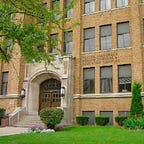After The Storm
By Martina Ibanez-Baldor
Danny Steeno, a senior majoring in biomedical sciences, was 8 years old when Hurricane Katrina struck the Gulf Coast in 2005, devastating the city of New Orleans. It was one of the deadliest hurricanes ever to hit the United States, displacing hundreds of thousands from their homes.
“I think I was too young to understand the gravity of what happened,” recalls Steeno. “It wasn’t until I went on my first MARDI GRAS trip to New Orleans that I actually learned everything that happened.”
Thirteen years later, Steeno acts as president of the Marquette student organization MARDI GRAS, which stands for Making A Real Difference in the Gulf Region and Areas Surrounding, and just completed his 10th trip to the city this past winter break. Four times a year, a group of 70 to 100 Marquette students drive down to the Lower Ninth Ward to continue a tradition of rebuilding the homes and hearts of residents affected by Hurricane Katrina.
Stephanie Treffert Lumpkin, M.D., H Sci ’10, had just started the first week of her freshman year at Loyola University New Orleans when Hurricane Katrina hit, effectively evacuating and displacing the entire student body for the fall semester. Marquette was one of the universities that took in uprooted students, including Lumpkin. In Milwaukee, the group of students looked for a way to stay connected to the city they had left behind. “We had seen that we should be contributing back to the community that we left, but didn’t have a great way of doing it,” Lumpkin recalls.
MARDI GRAS was quickly conceived, being officially chartered as a student organization that September. By October, just eight weeks after the storm hit, the first group of MARDI GRAS volunteers ventured down to New Orleans in three minivans. The trip was the chatter around campus, news of it quickly spreading by word of mouth. By winter break, another six weeks later, they made their second trip down with 108 students. “We actually had to start turning down people toward the end,” Lumpkin remembers. That first trip in 2005 was a reality check. The students slept in sleeping bags on the floor of an abandoned elementary school along with 600 other people. The organization they were working with told them if they wanted to eat dinner with them, they had to buy shovels. “That kind of forced us to step up our game and think about what are we really doing here,” Lumpkin recalls.
MARDI GRAS was quickly conceived, being officially chartered as a student organization that September. By October, just eight weeks after the storm hit, the first group of MARDI GRAS volunteers ventured down to New Orleans in three minivans. The trip was the chatter around campus, news of it quickly spreading by word of mouth. By winter break, another six weeks later, they made their second trip down with 108 students. “We actually had to start turning down people toward the end,” Lumpkin remembers.
That first trip in 2005 was a reality check. The students slept in sleeping bags on the floor of an abandoned elementary school along with 600 other people. The organization they were working with told them if they wanted to eat dinner with them, they had to buy shovels. “That kind of forced us to step up our game and think about what are we really doing here,” Lumpkin recalls. “We can’t bring people down here and drain the resources. We have to make sure that we are coming prepared.”
Prepared they came. In subsequent trips, they learned how to gut houses — all you needed was a hammer and a mask. They learned how to drywall and taught it to all the volunteers before the next trip. They learned about buying building tools and supplies. They learned how to catalog all their tools, about fundraising and financing. And they learned to become leaders and about the importance of service. “Marquette really teaches that concept of vocation, that you should figure out how you can contribute and then that’s how you should do it,” Lumpkin says.
For many students, the residents of the Lower Ninth Ward have had the same effect on MARDI GRAS volunteers as the volunteers have had on them. Charlie Pocius, H Sci ’17, a current physical therapy student and former MARDI GRAS executive board member, remembers, “The most eyeopening experience I ever had was talking to those homeowners, hearing their stories and beginning to understand their resilience and resolve.”
Today, the organization is looking beyond New Orleans to other places that need disaster relief.
“Our mission has always stayed the same. It’s always been about disaster relief and that same desire to go and be there for a group of people, a community that needs us the most,” says Steeno.
In 2012 Hurricane Sandy ripped through the Northeast, and the following year MARDI GRAS started making yearly spring break trips to the New York and New Jersey areas. In 2014 students traveled to Detroit after disastrous flooding caused an estimated $231 million in total property damage to the city. In 2016, when catastrophic flooding devastated Baton Rouge, Louisiana, a group of students already on the New Orleans trip drove the two hours to the city to aid in flood relief. And when Hurricane Harvey tore through Houston this past summer, MARDI GRAS students were eager to start planning a disaster relief trip to Texas. “We’re doing everything we can to get down there,” Steeno states.
Lumpkin, who is now a physician and training to be a surgeon, still makes frequent trips to New Orleans, where she’s able to show her husband the houses she once drywalled. With every year that passes since Hurricane Katrina, she is pleasantly surprised to hear the program is still going strong. “I’m always so impressed with young men and women stepping up to the plate and seeing that this is still something special.”
